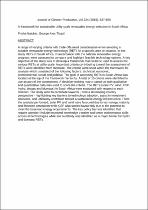 ResearchSpace
ResearchSpace
A framework for sustainable utility scale renewable energy selection in South Africa
JavaScript is disabled for your browser. Some features of this site may not work without it.
- ResearchSpace
- →
- Research Publications/Outputs
- →
- Journal Articles
- →
- View Item
| dc.contributor.author |
Naicker, Prisha

|
|
| dc.contributor.author |
Thopil, GA

|
|
| dc.date.accessioned | 2019-09-25T07:07:37Z | |
| dc.date.available | 2019-09-25T07:07:37Z | |
| dc.date.issued | 2019-07 | |
| dc.identifier.citation | Naicker, P. and Thopil, G.A. A framework for sustainable utility scale renewable energy selection in South Africa. Journal of Cleaner Production, v. 224, pp 637-650. | en_US |
| dc.identifier.issn | 0959-6526 | |
| dc.identifier.issn | 1879-1786 | |
| dc.identifier.uri | https://www.sciencedirect.com/science/article/pii/S0959652619309679 | |
| dc.identifier.uri | https://doi.org/10.1016/j.jclepro.2019.03.257 | |
| dc.identifier.uri | http://hdl.handle.net/10204/11127 | |
| dc.description | Copyright: 2019 Elsevier. Due to copyright restrictions, the attached PDF file only contains the abstract of the full text item. For access to the full text item, kindly consult the publisher's website. | en_US |
| dc.description.abstract | A range of varying criteria with trade-offs need consideration when selecting a suitable renewable energy technology (RET) for a specific area or location. In this study RETs in South Africa, in accordance with the national renewable energy program, were assessed to compare and highlight feasible technology options. A key objective of the study was to develop a framework that could be used to assess the various RETs at utility scale. Important criteria contributing toward the assessment of RETs were identified from literature. The criteria were used within the framework for analysis which consisted of the following factors: technical, economic, environmental, social and political. The goal of assessing RETs in South Africa was located at the top of the framework hierarchy. A total of 15 criteria were identified to use as part of the assessment. A decision-making matrix based on both qualitative and quantitative data was used to score the criteria. The RETs (solar PV, wind, CSP, hydro, biogas and biomass) in South Africa were evaluated with respect to each criterion. The study aims to contribute towards - from a developing country perspective - highlighting key barriers to technology adoption, assist in investment decisions, and ultimately contribute toward a sustainable energy infrastructure. From the analysis performed, solar PV and wind were favoured due to technology maturity and financier perception while CSP also scored favourably due to the potential to meet the baseload energy requirements. The key policy barriers identified that require attention include improved knowledge transfer and better maintenance skills across all technologies while site suitability was identified as a major barrier for hydro and biomass RETs. | en_US |
| dc.language.iso | en | en_US |
| dc.publisher | Elsevier | en_US |
| dc.relation.ispartofseries | Worklist;22639 | |
| dc.subject | Renewable energy | en_US |
| dc.subject | Multi-criteria analysis | en_US |
| dc.subject | Decision-making matrix | en_US |
| dc.title | A framework for sustainable utility scale renewable energy selection in South Africa | en_US |
| dc.type | Article | en_US |
| dc.identifier.apacitation | Naicker, P., & Thopil, G. (2019). A framework for sustainable utility scale renewable energy selection in South Africa. http://hdl.handle.net/10204/11127 | en_ZA |
| dc.identifier.chicagocitation | Naicker, Prisha, and GA Thopil "A framework for sustainable utility scale renewable energy selection in South Africa." (2019) http://hdl.handle.net/10204/11127 | en_ZA |
| dc.identifier.vancouvercitation | Naicker P, Thopil G. A framework for sustainable utility scale renewable energy selection in South Africa. 2019; http://hdl.handle.net/10204/11127. | en_ZA |
| dc.identifier.ris | TY - Article AU - Naicker, Prisha AU - Thopil, GA AB - A range of varying criteria with trade-offs need consideration when selecting a suitable renewable energy technology (RET) for a specific area or location. In this study RETs in South Africa, in accordance with the national renewable energy program, were assessed to compare and highlight feasible technology options. A key objective of the study was to develop a framework that could be used to assess the various RETs at utility scale. Important criteria contributing toward the assessment of RETs were identified from literature. The criteria were used within the framework for analysis which consisted of the following factors: technical, economic, environmental, social and political. The goal of assessing RETs in South Africa was located at the top of the framework hierarchy. A total of 15 criteria were identified to use as part of the assessment. A decision-making matrix based on both qualitative and quantitative data was used to score the criteria. The RETs (solar PV, wind, CSP, hydro, biogas and biomass) in South Africa were evaluated with respect to each criterion. The study aims to contribute towards - from a developing country perspective - highlighting key barriers to technology adoption, assist in investment decisions, and ultimately contribute toward a sustainable energy infrastructure. From the analysis performed, solar PV and wind were favoured due to technology maturity and financier perception while CSP also scored favourably due to the potential to meet the baseload energy requirements. The key policy barriers identified that require attention include improved knowledge transfer and better maintenance skills across all technologies while site suitability was identified as a major barrier for hydro and biomass RETs. DA - 2019-07 DB - ResearchSpace DP - CSIR KW - Renewable energy KW - Multi-criteria analysis KW - Decision-making matrix LK - https://researchspace.csir.co.za PY - 2019 SM - 0959-6526 SM - 1879-1786 T1 - A framework for sustainable utility scale renewable energy selection in South Africa TI - A framework for sustainable utility scale renewable energy selection in South Africa UR - http://hdl.handle.net/10204/11127 ER - | en_ZA |





